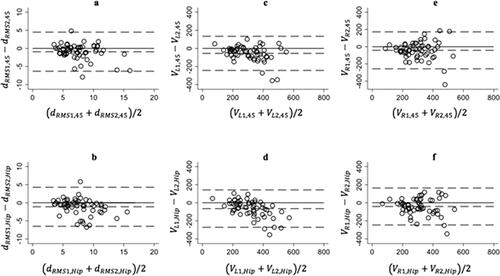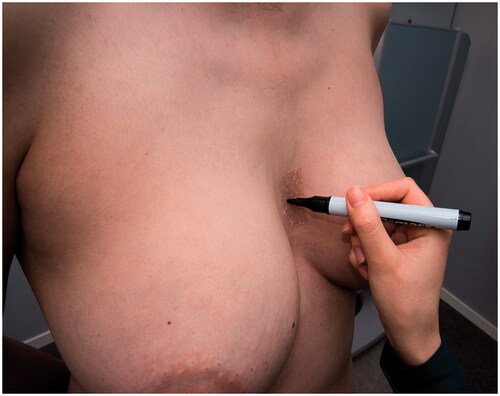Figures & data
Figure 2. (a) Analysis in VECTRA Analysis Module, measurement of the breast area of interest (turquoise) for calculations of the mean distance between the two breast surfaces () as an expression for breast symmetry and (b) volume measurement of the left breast against the interpolated virtual chest wall (brown). Skin marks adjusted in relation to the xyz-plane.

Figure 3. Illustration of the coordinates and data used to obtain the mean distance between two breast surfaces () and the characteristic diameter (
) of the left (blue) and the right (maroon) breast, calculated from the measured volumes of the breasts in VECTRA Analysis Module.
is calculated based on measuring the shortest distance between more than 1000 points on one surface to the corresponding points on the other surface.

Table 1. Clinical data of the study sample.
Table 2. Estimates of agreement and reproducibility of breast symmetry (), left breast volume (
), and right breast volume (
), in two different postures, 45° arm abduction and hands placed on hips.
Table 3. Estimates of volume-shape-symmetry () agreement and reproducibility, based on raw data measurements from the three-dimensional surface images including the variance components, presented for two postures (arms at 45° and hands placed on hips).
Figure 4. (a) Bland–Altman’s plots of the inter-observer reproducibility comparing observer 1 in relation to observer 2 with corresponding limits of agreement (upper and lower dashed lines) for breast symmetry measurements with arms at 45° (), (b) breast symmetry with hands on the hips (
), (c) left breast volume at 45° (
), (d) left breast volume with hands on the hips (
), (e) right breast volume at 45° (
), and (f) right breast volume with hands on the hips (
).
for measurements by observer 1,
for measurements by observer 2.

Table 4. Spearman’s rank correlation (ρ) between breast symmetry () and breast volume differences (
) of measurements from six 3D surface images of 58 women captured in two different postures (45° and hands placed on hips) obtained by two observers.

